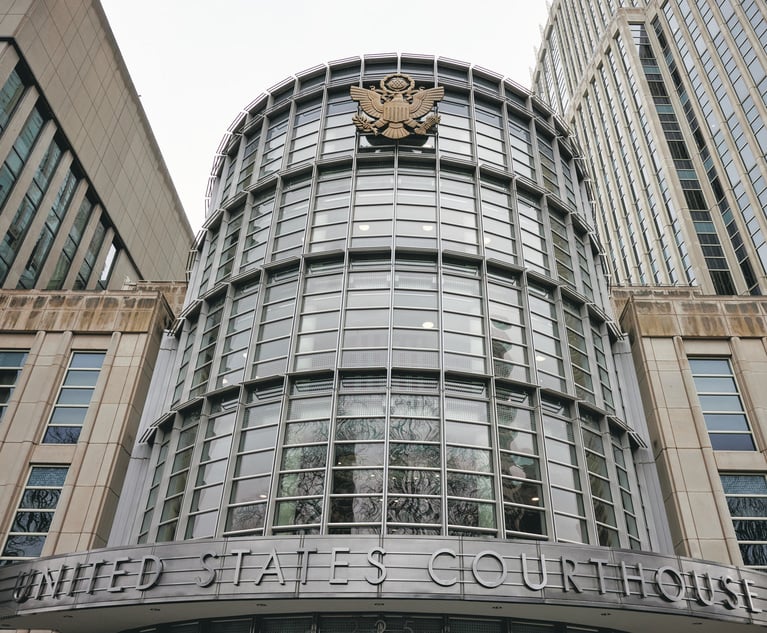New Federal Law Clerk Hiring Plan Gets High Marks From Chief Judge Robert Katzmann
"It's a work in progress, but I think the objectives are sound," said Chief Judge Robert Katzmann of the U.S. Court of Appeals for the Second Circuit. "We all have to continue to work together to straighten out the kinks we think there may have been so that next year is better.”
July 03, 2019 at 12:43 PM
8 minute read
The original version of this story was published on Law.com
 Robert Katzmann, Chief United States Circuit Judge of the U.S. Court of Appeals for the Second Circuit. Photo: David Handschuh.
Robert Katzmann, Chief United States Circuit Judge of the U.S. Court of Appeals for the Second Circuit. Photo: David Handschuh.
The federal judiciary's latest attempt to impose order to the clerk hiring process is off to a promising start.
Judges and law school clerkship advisers are reporting that a pilot federal law clerk hiring plan, which kicked off June 17, appears to have cut down on the practice of judges selecting clerks before the end of their second year of law school and has helped make the application process more transparent.
It's the first attempt to standardize federal clerk hiring since a predecessor plan fell apart in 2014. Clerk hiring had become more chaotic as a result, with some judges making offers with little more to go on than one year of grades, while information about when and how judges were hiring became more opaque.
But the latest plan is still in its infancy, and federal judges are a notoriously difficult group to corral, experts cautioned. It remains unclear what percent of U.S. appellate and district court judges are following the guidelines of the two-year pilot plan, which is voluntary, though the judges behind the plan expect to collect data on that later this summer.
“Most of my colleagues have said they like the idea of having more information about the students,” said Chief Judge Robert Katzmann of the U.S. Court of Appeals for the Second Circuit, who is one of four chief circuit court judges who put the plan together. “It's a work in progress, but I think the objectives are sound. The rationale behind the plan remains sound. We all have to continue to work together to straighten out the kinks we think there may have been so that next year is better.”
A second appellate judge, who spoke anonymously but who has signed on to the plan, said feedback from colleagues on the bench has been positive.
“The judges I've spoken to are happy about the way it has worked out and were happy not to have to look at applications until law students have had two years of law school under their belt,” said the judge. “And the professors I've spoken to seem relieved to not have students applying for clerkships in their first or second semester of their first year.”
Clerkships advisers said the hiring season began June 17 with a flurry of activity, and hiring has continued into the third week at a steady rate. That pace indicates that judges are taking different approaches to finding clerks. Some snapped up clerks in the first several days allowed under the plan, while others are taking more time to sift through applications and conduct interviews at their convenience.
Some University of Chicago law students juggled multiple interview requests in the first several days of the plan—some on opposite sides of the country—said career services Dean Lois Casaleggi. But her office has also counseled many students to be patient even if they didn't receive interview requests in the first week of the plan. She expects hiring to continue throughout the summer and even into the academic year, albeit at a slower pace.
“There's a sense that June 17 was a deadline, but it's really just a start date,” Casaleggi said. “Judges can proceed however they want. They can start making calls right away, or they can take some time to read the applications. Some judges are 100% done. They finished that first week. I think there are judges out there who are taking more time to read applications, and bring people in on a schedule that works for them. The plan lets them do that.”
Katzmann said that he hired new clerks over the course of the plan's first week, rather than cramming hiring into the first several days.
The new plan was put together by the chief justices of four circuit courts: Katzmann, Judge Merrick Garland of the U.S. Court of Appeals for the D.C. Circuit, Judge Diane Wood of the U.S. Court of Appeals for the Seventh Circuit, and Sidney Thomas of the U.S. Court of Appeals for the Ninth Circuit. They announced the plan in February 2018, and the First and Third Circuits have indicated that they are following it.
But not all judges on those circuits are necessarily following the plan, and it's not clear how many district court judges are on board.
Under the plan, judges wait until a predetermined date in June to accept applications from students who have just completed their second year of law school. On that date, they may start interviewing and making offers. Judges on the plan must give applicants 48 hours to accept the offer, allowing them time to interview with other judges. The plan applies only to law students, not law graduates. It has enjoyed widespread support from law deans, some of whom pushed to reinstate clerk hiring guidelines.
“A very important part of the plan is the 48-hour grace period so there won't be exploding offers, and it appears judges did not explode offers,” said the appellate judge. “They permitted applicants to fly around the country if necessary, and do interview by Skype and telephone. The law professors appear to have, by and large, abided by the plan and did not provide recommendations to anyone before the 17th.”
Some judges have told Katzmann that they would prefer to have a day or two-day “reading period” to review applications before anyone is allowed to interview candidates—a tweak that will be considered for the next hiring cycle, he said.
At the University of Pennsylvania Law School, fewer students applied to clerkships or were interviewed by judges during their first or second years, according to career services Dean Maureen Reilly—which was a core aim of the pilot plan. The dissolution of the previous hiring plan led to something of a race among judges to land top clerk prospects, with hiring decisions happening ever earlier. Pushing clerk hiring back to the summer after the second year allows students to opportunity to show two years of grades and other qualifications, while giving judges a more robust track record to examine when hiring. It also allows law students to focus on acclimating to law school and their academics in the first year, rather than scrambling to land a clerkship.
“I think a lot of people support the idea. It makes a lot of sense,” Reilly said. “But it will depend on how many judges participate and how well they think it's working for them.”
Another benefit of the hiring plan is that it levels the playing field somewhat for first-generation law students and others without legal connections, Katzmann said.
“The previous system, where you had law students being chosen in their first year, gave a real advantage to students who were well connected, or who have parents who are in the legal profession and knew what the process of getting clerkship is and how you connect with faculty,” he said. “It changed the whole first year experience when law students were chosen after only one year.”
Carl Tobias, a professor at the University of Richmond School of Law who tracks clerkship trends, said the future of the plan depends largely on how clerk hiring plays out this cycle. Participating circuit courts have only committed to the plan through 2020 and will reevaluate whether to stick with it after that. But there has been little public discussion of the plan since it went into effect and hard data on the number of judges participating and whether they are closely adhering to the rules is difficult to come by, he said.
The previous clerk hiring plan debuted in 2003 and gained momentum in 2005 with the introduction of Online System for Clerkship Application and Review, better known as OSCAR, which allows applicants and law schools to submit materials online and lets judges sort applications by specific criteria, such as school or grade-point average. But judges had began abandoning the plan by 2010, and it dissolved in 2014.
Casaleggi said she hopes the new plan sticks around. But she has seen enough clerk hiring plans fall by the wayside to be skeptical.
“I just don't think this is a market where you can tell these employers how to hire,” she said. “Yes, it's the federal judiciary, but that's not a universal employer. Each judge is his or her own employer. I've seen plans come and I've seen plans go. I don't know that this is a market suited to a strict structure.”
This content has been archived. It is available through our partners, LexisNexis® and Bloomberg Law.
To view this content, please continue to their sites.
Not a Lexis Subscriber?
Subscribe Now
Not a Bloomberg Law Subscriber?
Subscribe Now
NOT FOR REPRINT
© 2025 ALM Global, LLC, All Rights Reserved. Request academic re-use from www.copyright.com. All other uses, submit a request to [email protected]. For more information visit Asset & Logo Licensing.
You Might Like
View All
The Met Hires GC of Elite University as Next Legal Chief

NY Appellate Panel Cites Student's Disciplinary History While Sending Negligence Claim Against School District to Trial

'No Evidence'?: Big Law Firms Defend Academic Publishers in EDNY Antitrust Case
3 minute read
'Substantive Deficiencies': Judge Grants Big Law Motion Dismissing Ivy League Price-Fixing Claims
3 minute readTrending Stories
- 1Starbucks Sues Ex-Executive to Recover $1M Signing Bonus
- 2Navigating AI Risks: Best Practices for Compliance and Security
- 320 New Judges? Connecticut Could Get Wave of Jurists
- 4Orrick Loses 10-Lawyer Team to Herbert Smith in Germany
- 5‘The US Market Is Critical’: KPMG’s Former Head of Global Legal Services On the Legal Arm of the Big Four Firm Entering the US
Who Got The Work
J. Brugh Lower of Gibbons has entered an appearance for industrial equipment supplier Devco Corporation in a pending trademark infringement lawsuit. The suit, accusing the defendant of selling knock-off Graco products, was filed Dec. 18 in New Jersey District Court by Rivkin Radler on behalf of Graco Inc. and Graco Minnesota. The case, assigned to U.S. District Judge Zahid N. Quraishi, is 3:24-cv-11294, Graco Inc. et al v. Devco Corporation.
Who Got The Work
Rebecca Maller-Stein and Kent A. Yalowitz of Arnold & Porter Kaye Scholer have entered their appearances for Hanaco Venture Capital and its executives, Lior Prosor and David Frankel, in a pending securities lawsuit. The action, filed on Dec. 24 in New York Southern District Court by Zell, Aron & Co. on behalf of Goldeneye Advisors, accuses the defendants of negligently and fraudulently managing the plaintiff's $1 million investment. The case, assigned to U.S. District Judge Vernon S. Broderick, is 1:24-cv-09918, Goldeneye Advisors, LLC v. Hanaco Venture Capital, Ltd. et al.
Who Got The Work
Attorneys from A&O Shearman has stepped in as defense counsel for Toronto-Dominion Bank and other defendants in a pending securities class action. The suit, filed Dec. 11 in New York Southern District Court by Bleichmar Fonti & Auld, accuses the defendants of concealing the bank's 'pervasive' deficiencies in regards to its compliance with the Bank Secrecy Act and the quality of its anti-money laundering controls. The case, assigned to U.S. District Judge Arun Subramanian, is 1:24-cv-09445, Gonzalez v. The Toronto-Dominion Bank et al.
Who Got The Work
Crown Castle International, a Pennsylvania company providing shared communications infrastructure, has turned to Luke D. Wolf of Gordon Rees Scully Mansukhani to fend off a pending breach-of-contract lawsuit. The court action, filed Nov. 25 in Michigan Eastern District Court by Hooper Hathaway PC on behalf of The Town Residences LLC, accuses Crown Castle of failing to transfer approximately $30,000 in utility payments from T-Mobile in breach of a roof-top lease and assignment agreement. The case, assigned to U.S. District Judge Susan K. Declercq, is 2:24-cv-13131, The Town Residences LLC v. T-Mobile US, Inc. et al.
Who Got The Work
Wilfred P. Coronato and Daniel M. Schwartz of McCarter & English have stepped in as defense counsel to Electrolux Home Products Inc. in a pending product liability lawsuit. The court action, filed Nov. 26 in New York Eastern District Court by Poulos Lopiccolo PC and Nagel Rice LLP on behalf of David Stern, alleges that the defendant's refrigerators’ drawers and shelving repeatedly break and fall apart within months after purchase. The case, assigned to U.S. District Judge Joan M. Azrack, is 2:24-cv-08204, Stern v. Electrolux Home Products, Inc.
Featured Firms
Law Offices of Gary Martin Hays & Associates, P.C.
(470) 294-1674
Law Offices of Mark E. Salomone
(857) 444-6468
Smith & Hassler
(713) 739-1250






